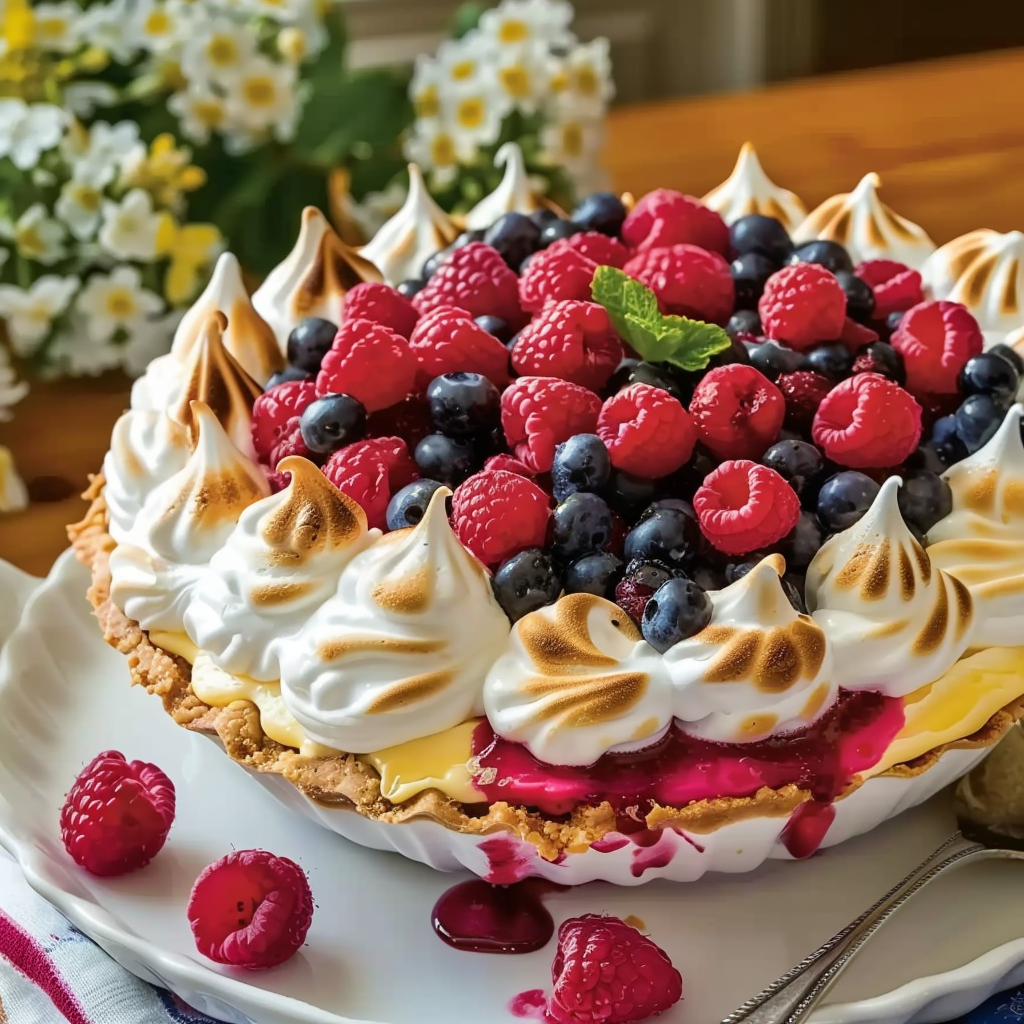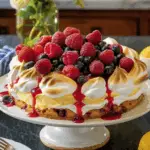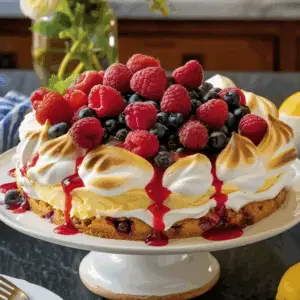A Slice of Summer in Every Bite
The perfect dessert is one that blends texture, flavor, and elegance — and Lemon Raspberry Meringue Cheesecake delivers all three in every slice. This luscious treat offers a creamy lemon cheesecake base, a vibrant raspberry swirl, and a pillowy meringue topping, toasted to golden perfection. Every bite is the ideal balance of sweet, tart, and smooth, wrapped in a crunchy graham cracker crust.
Cheesecake lovers often search for something that feels bakery-level but is simple enough to make at home. That’s exactly where this dessert shines. With a few basic ingredients, it elevates traditional cheesecake with a twist that impresses at gatherings or brings a touch of luxury to an ordinary weeknight.
Unlike traditional fruit-topped cheesecakes, this version integrates the raspberry right into the batter, creating a gorgeous swirl pattern. The technique echoes professional pastry presentation, similar to what you’ll see on Pinterest when exploring raspberry swirl techniques. The result is not just delicious but also eye-catching on any dessert table.
Combining citrus brightness with berry depth, this cheesecake pays homage to the classic cheesecake while giving it a summer upgrade. It also avoids the overly dense texture of many baked cheesecakes, opting instead for something silkier thanks to ingredients like sour cream and fresh lemon juice.
If you’re looking for a showstopper that’s as satisfying to slice as it is to savor, this cheesecake checks every box. It’s a dessert that slices cleanly, holds its shape, and leaves everyone reaching for seconds.
What Makes This Cheesecake Unique?
What sets the Lemon Raspberry Meringue Cheesecake apart from other desserts is its masterful combination of flavors, textures, and visual appeal. At its heart, this cheesecake isn’t just about being rich and creamy — it’s about balance. The zesty lemon brightens the palate, the tart raspberries cut through the sweetness, and the toasted meringue adds a soft, airy contrast to the dense base.
Each component plays a distinct role in building the final flavor experience:
-
Lemon cheesecake base: Infused with fresh lemon juice and lemon zest, the filling delivers a citrus-forward taste that refreshes rather than overwhelms.
-
Raspberry swirl: Made with either raspberry jam or preserves and fresh raspberries, the swirl adds bursts of fruity tartness in every bite. It creates a beautiful marbled effect reminiscent of designs often featured on Pinterest dessert boards.
-
Toasted meringue topping: Light, sweet, and slightly crisp on the surface, the meringue is whipped to glossy peaks and toasted just before serving. It’s similar in structure to traditional meringue, offering a nostalgic nod to lemon meringue pie.
Another feature that makes this recipe stand out is its presentation. It slices clean and smooth, which isn’t always the case with berry-based cheesecakes. The integration of the swirl within the batter, rather than only on top, minimizes mess and boosts visual appeal — an ideal solution for elegant events or bakery-style displays.
Baking enthusiasts will also appreciate how the recipe avoids common pitfalls. It uses flour and sour cream to stabilize the filling without compromising texture, which is a technique often found in professionally tested cheesecake recipes. This leads to fewer cracks and a more even bake, reducing the need for a water bath — though that remains an option for added insurance.
If you’re curious about the history of some of these core ingredients, the cream cheese base dates back centuries and has remained a staple due to its smoothness and mild tang. Pairing it with lemon and raspberry brings a contemporary flair to a time-tested dessert.
Whether you’re making it for a summer get-together, a birthday celebration, or just treating yourself on the weekend, this cheesecake is more than just a dessert — it’s an experience.
Ingredient Breakdown & Substitutions
Creating a bakery-worthy Lemon Raspberry Meringue Cheesecake starts with understanding each component’s role. Every ingredient contributes to the texture, flavor, or structure, making this dessert both indulgent and refined. Here’s a breakdown of the key elements and smart substitutions if you’re missing something or need to accommodate dietary needs.
Crust Ingredients
-
Graham cracker crumbs: The base of the crust provides a slightly sweet, toasty crunch that pairs perfectly with the creamy filling. A classic choice, it’s widely used in American-style cheesecakes. Learn more about its background and variations on the Graham cracker crust Wikipedia page.
-
Melted butter: Acts as the binder, helping crumbs hold together when pressed into the pan.
-
Granulated sugar: Adds sweetness and encourages browning during baking.
Substitutions:
-
Swap graham crackers with digestive biscuits, vanilla wafers, or gingersnaps for a spiced twist.
-
For a gluten-free version, opt for gluten-free cookies or almond flour mixed with butter and sugar.
Lemon Cheesecake Filling
-
Cream cheese (24 oz): The core of the cheesecake — soft, tangy, and creamy. It’s critical that it’s fully softened to avoid lumps in your batter. For more info, explore what makes cream cheese essential in baking.
-
Granulated sugar (1 cup): Sweetens the filling and balances the lemon’s acidity.
-
Eggs (3 large): Provide structure, allowing the cheesecake to firm up as it bakes.
-
Vanilla extract (1 tsp): Enhances flavor and balances the citrus notes.
-
Sour cream (½ cup): Adds moisture and richness, helping achieve that silky finish.
-
All-purpose flour (2 tbsp): A small amount ensures stability without making the texture too dense.
-
Lemon zest + juice: The zest intensifies lemon flavor while the juice provides brightness and tang. This citrus component helps cut through the richness of the cheese.
-
Raspberry preserves or jam (½ cup) and fresh raspberries (½ cup): Provide the fruit swirl and tart bursts throughout the filling. The swirl technique can be seen in many visual tutorials like this raspberry swirl technique.
Substitutions:
-
If fresh raspberries aren’t in season, use frozen raspberries — just thaw and drain them thoroughly.
-
Swap raspberry preserves with blackberry or strawberry jam for flavor variety.
-
Greek yogurt can be used in place of sour cream for a slight tangier profile.
Meringue Topping
-
Egg whites (4 large): These form the airy base of the meringue.
-
Granulated sugar (½ cup): Stabilizes the whipped whites and adds sweetness.
-
Cream of tartar (¼ tsp): Helps the egg whites reach stiff, glossy peaks. You can learn more about meringue techniques and their role in baking.
-
Vanilla extract (½ tsp): Adds subtle flavor to the meringue.
Substitutions:
-
If cream of tartar isn’t available, use a few drops of lemon juice or white vinegar as an acid to stabilize the egg whites.
-
Consider flavored extracts like almond or lemon for a unique twist.
Each layer — from crust to topping — brings a critical flavor and textural contrast that makes the cheesecake feel elevated yet approachable. For visual examples of decorated meringue finishes, browse Pinterest’s toasted meringue inspiration to refine your presentation.
Equipment Checklist
Before diving into the baking process, it’s essential to gather the right tools. Proper equipment not only makes the process smoother but also ensures professional-looking results — from a firm crust to a toasted meringue topping that holds its shape. Here’s what you’ll need to recreate this lemon raspberry meringue cheesecake with ease:
-
9-inch springform pan: A must-have for cheesecakes. The removable sides allow you to release the cake without damaging the crust or top. A springform pan also helps maintain the cheesecake’s clean edges.
-
Mixing bowls (various sizes): You’ll need at least two — one for the crust and filling, another for whipping the meringue.
-
Electric hand mixer or stand mixer: Essential for achieving a smooth, lump-free filling and for beating egg whites into stiff, glossy peaks. For guidance on achieving perfect meringue texture, check out this meringue tutorial.
-
Rubber spatula: Ideal for folding ingredients gently and scraping down the sides of bowls.
-
Offset spatula or piping bag: Useful for spreading or decorating the meringue topping, especially if you’re going for a decorative finish as seen in Pinterest cheesecake ideas.
-
Toothpick or skewer: Needed for swirling the raspberry preserve into the cheesecake batter to create a marbled pattern.
-
Kitchen torch or broiler: A kitchen torch gives you control when toasting the meringue, ensuring a golden finish without overcooking. If you don’t have one, a broiler will work, but requires close monitoring.
-
Parchment paper: Lining the pan base makes for easier removal and a cleaner bottom.
-
Measuring cups and spoons: Precision is critical in cheesecake recipes, especially when it comes to ingredients like flour, lemon juice, or sugar.
-
Baking sheet: Placing the springform pan on a baking sheet makes transferring to the oven easier and can catch any overflow or drips.
While none of the tools are overly specialized, they do contribute to achieving bakery-quality results — a goal of this recipe. Tools like the kitchen torch or offset spatula elevate presentation, while others like the springform pan and mixer are crucial for proper texture and structure.
To ensure the perfect finish, explore more professional cheesecake presentation tips using this Pinterest guide. With the right tools in hand, you’re already halfway to a flawless result.
Step-by-Step: Making the Graham Crust
The graham cracker crust forms the foundation of your cheesecake — buttery, slightly sweet, and perfectly crisp. This layer should be firm enough to hold the creamy filling without crumbling when sliced. Here’s how to create a reliable base that complements the tangy lemon and raspberry layers above it.
1. Combine the ingredients
In a medium bowl, mix:
-
1½ cups graham cracker crumbs
-
⅓ cup melted unsalted butter
-
¼ cup granulated sugar
Stir until the mixture resembles damp sand. The butter should coat the crumbs evenly, binding them together for pressing.
2. Prepare the pan
Line the bottom of a 9-inch springform pan with parchment paper. This step ensures easy removal after chilling. Lightly grease the sides to prevent sticking.
3. Press the crust
Pour the crust mixture into the pan. Using the bottom of a flat measuring cup or glass, press the crumbs down evenly, focusing on creating a compact layer. A firm crust is essential for holding up the cheesecake and avoiding a crumbly bottom.
4. Bake briefly
Preheat the oven to 325°F (160°C). Bake the crust for 10 minutes. This step toasts the crumbs slightly and helps the crust set, preventing sogginess later. Once baked, let it cool while you prepare the filling.
This graham cracker crust is a reliable and adaptable base. For more about its history and structure, explore the graham cracker crust entry on Wikipedia. You can also try variations with gingersnaps or digestive biscuits to suit your flavor preferences.
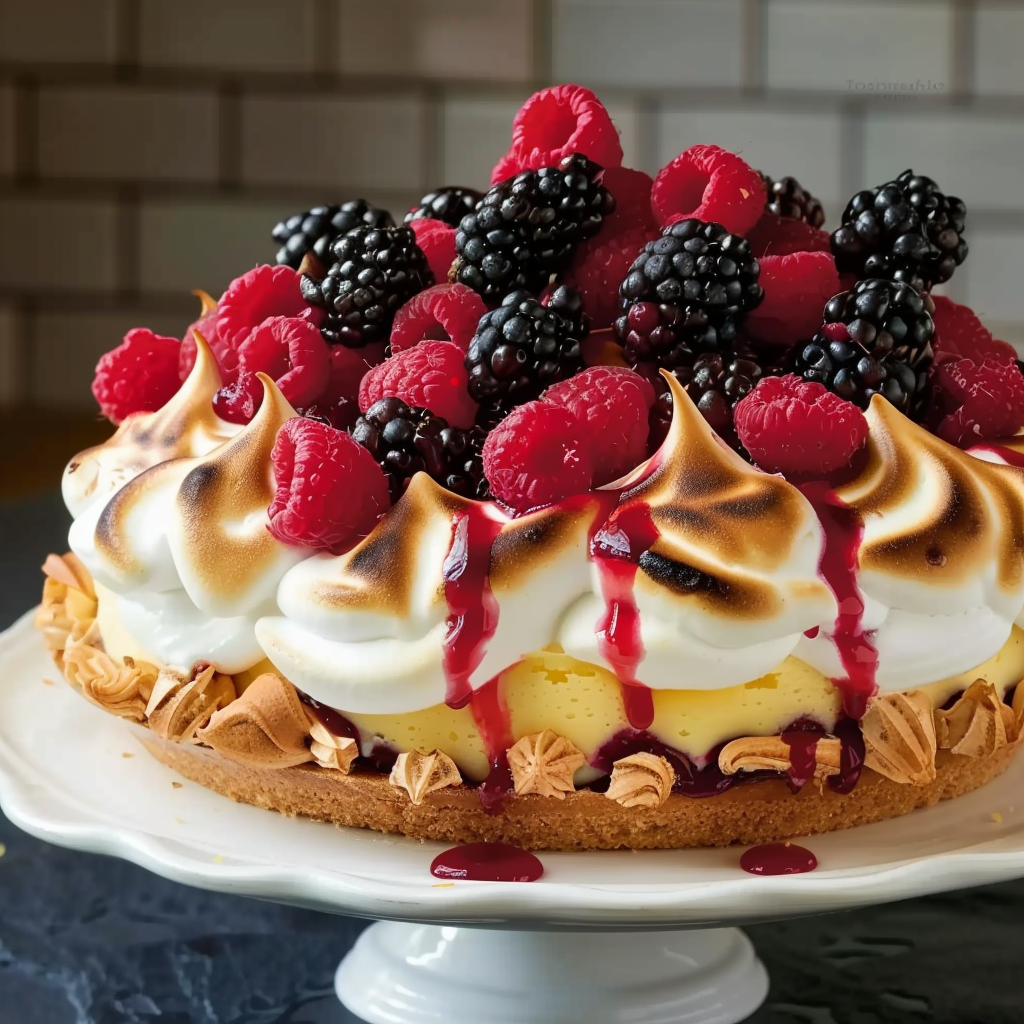
Creating the Creamy Lemon Cheesecake Filling
The filling is the soul of the cheesecake — silky, tangy, and rich, with the right balance of structure and softness. Achieving a smooth, lump-free texture and vibrant lemon flavor is key.
1. Beat the cream cheese
In a large mixing bowl, beat 24 oz softened cream cheese until completely smooth. This step is crucial — any lumps now will remain after baking. Use a stand mixer or hand mixer on medium speed.
2. Add sugar and eggs
Add 1 cup granulated sugar and continue to beat until light and fluffy. Then, mix in 3 large eggs, one at a time, beating well after each. This gradual addition creates a uniform and stable batter.
3. Enhance with flavor
Mix in:
-
1 tsp vanilla extract
-
½ cup sour cream
-
2 tbsp all-purpose flour
-
Zest of 1 lemon
-
⅓ cup fresh lemon juice
This combination delivers a bright, tangy flavor while maintaining a creamy texture. The flour helps thicken the filling slightly, preventing cracks.
4. Layer the raspberry swirl
Pour half the cheesecake batter into the cooled crust. Drop spoonfuls of raspberry preserves over the batter, then gently swirl using a skewer or knife. Add half of the fresh raspberries. Repeat with the remaining batter and another swirl of jam and raspberries.
For an eye-catching finish, use techniques shown in this raspberry swirl tutorial.
Assembling the Layers: Cheesecake & Raspberry Swirl
This step is where artistry meets baking science. Layering and swirling not only enhance the look of the cheesecake but also ensure even fruit distribution in every slice.
Layer 1: Pour half of the prepared lemon cheesecake filling over the baked crust. Tap the pan lightly on the counter to release any air bubbles.
Raspberry swirl: Drop spoonfuls (about ½ tsp each) of raspberry preserves over the surface. Using a toothpick or skewer, gently swirl the preserves into the batter — avoid overmixing, which can muddy the appearance. Add half the fresh raspberries, spacing them evenly.
Layer 2: Pour the remaining cheesecake batter over the first layer. Repeat the swirling process with more preserves and the remaining raspberries.
Swirling too deep can cause the jam to sink, so keep it close to the surface. If you want visual inspiration, explore these cheesecake decoration ideas for professional-level finishes.
Baking the Cheesecake to Perfection
Baking is where many cheesecakes go wrong — cracking tops, sunken centers, or overbaking are common issues. Here’s how to avoid them and get a smooth, set, and crack-free finish.
1. Preheat the oven to 325°F (160°C). Place the springform pan on a baking sheet to catch any potential drips.
2. Bake for 50–60 minutes
The edges should look set while the center remains slightly jiggly — not liquid, but with a wobble when shaken gently. Overbaking causes cracks, so rely on visual cues rather than exact time.
3. Skip the water bath (optional)
A water bath helps prevent cracking but isn’t strictly necessary for this recipe, thanks to the stabilizers in the filling. However, if you prefer added moisture, place a separate pan of hot water on the lower oven rack to create steam.
4. Cool slowly
Turn off the oven and leave the cheesecake inside with the door slightly open for 1 hour. This gradual cooling prevents the surface from sinking or cracking.
5. Refrigerate to set
After cooling at room temperature, refrigerate the cheesecake for at least 4 hours or overnight. This allows the flavors to develop and the texture to firm up.
For deeper insight into cheesecake history and structure, explore the cheesecake Wikipedia article.
Cooling, Chilling & Setting
After baking, proper chilling is essential to achieve the classic, firm texture and clean slices cheesecake is known for.
-
Initial cooling: Let the cheesecake sit in the turned-off oven with the door cracked open for 1 hour.
-
Room temperature: Cool completely on a wire rack before refrigerating.
-
Chill time: At least 4 hours in the fridge, but overnight is best. This ensures a clean cut and full flavor development.
-
Serving tip: For neat slices, run a knife under hot water, wipe it dry, then slice. Repeat between cuts.
This process might seem slow, but patience is key. Rushing the cooling or skipping the chill can lead to a runny center or soggy crust.
Making and Toasting the Meringue Topping
The toasted meringue is what sets this cheesecake apart from others. It adds sweetness, height, and a beautiful finish — especially when lightly browned.
1. Prepare the meringue
In a clean, grease-free bowl, beat 4 egg whites and ¼ tsp cream of tartar until soft peaks form. Gradually add ½ cup granulated sugar, then beat on high until stiff, glossy peaks form. Finish with ½ tsp vanilla extract.
2. Apply the meringue
Once the cheesecake is completely chilled, spread the meringue over the top using a spatula or pipe it decoratively with a bag. Avoid overloading the edges to prevent dripping.
3. Toast it
Use a kitchen torch to lightly brown the meringue, moving in circles for even color. Alternatively, place under the broiler for 1–2 minutes, watching closely. Explore toasted meringue tutorials for styling ideas.
This step should be done just before serving or a few hours in advance. If refrigerated, the meringue may begin to weep slightly — a natural reaction that doesn’t affect taste.
Serving Suggestions & Variations
There are endless ways to adapt and serve this cheesecake based on preference, season, or occasion.
Garnish ideas:
-
Fresh raspberries or lemon slices
-
Mint leaves
-
Powdered sugar dusting
Serving tips:
-
Serve chilled for best texture
-
Wipe knife between each slice for a clean cut
Variations:
-
Use blueberries instead of raspberries
-
Make mini cheesecakes in muffin tins — perfect for parties (mini cheesecake inspiration)
-
Make crustless for a gluten-free version using almond flour and omitting the base
Cheesecake is a versatile dessert, and this version is perfect for customizing. Whether you’re adding seasonal fruits or changing the swirl flavor, the base remains delicious and reliable.
Storage, Make-Ahead & Freezing Tips
Proper storage ensures your cheesecake stays fresh, flavorful, and attractive.
Storage:
-
Store in the fridge for up to 4–5 days, loosely covered with plastic wrap or in a cake dome.
Make-ahead:
-
Prepare the cheesecake a day before your event and add meringue topping just before serving or up to 4 hours in advance.
Freezing:
-
Freeze the cheesecake (without meringue) wrapped in plastic and foil for up to 2 months. Thaw overnight in the fridge.
-
Do not freeze with meringue — it will separate and lose texture.
Check out these Pinterest tips for cheesecake storage if planning for future events.
Troubleshooting Common Mistakes
Even seasoned bakers run into cheesecake challenges. Here’s how to fix and prevent common issues:
-
Cracked top: Avoid overbaking and allow slow cooling. A cracked top can be hidden under meringue.
-
Grainy texture: Usually from cold cream cheese or overmixing. Always use room temperature ingredients and mix just until combined.
-
Runny center: Underbaked or not chilled long enough. The center should jiggle slightly but not ripple like liquid.
-
Weepy meringue: Occurs from overbeating or humidity. Add cream of tartar for stability and toast just before serving.
-
Soggy crust: Ensure crust is baked and cooled before adding filling. Use a firm press and don’t skip the 10-minute pre-bake.
For added texture and visual guidance, explore more cheesecake decoration techniques.
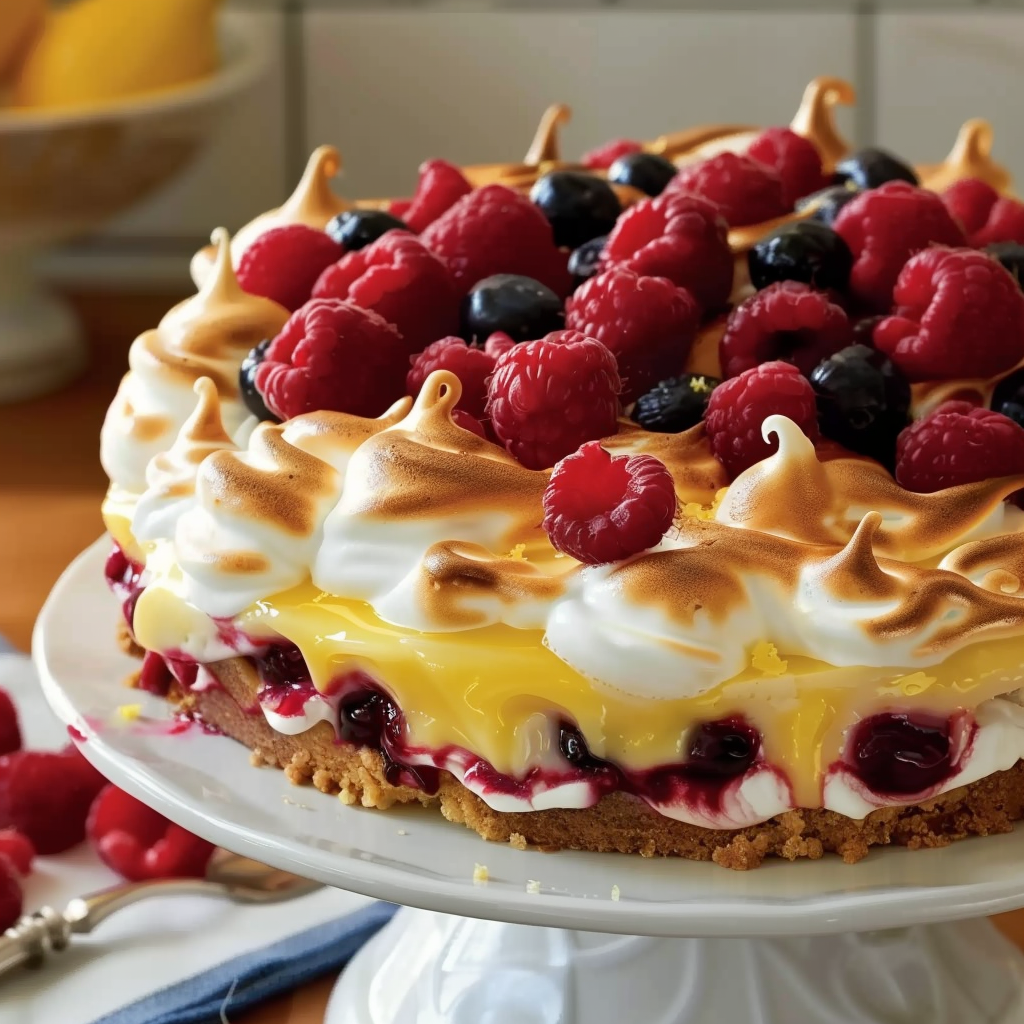
FAQs
Can I use frozen raspberries in cheesecake?
Yes, but thaw and drain them thoroughly to avoid adding extra moisture to the batter.
How do you make meringue that doesn’t collapse?
Use room temperature egg whites, add cream of tartar, and beat to stiff peaks. Avoid overbeating.
Is it safe to torch meringue on cheesecake?
Yes, using a kitchen torch is safe and effective. Keep the flame moving and avoid overheating one spot.
Why is my cheesecake not setting properly?
It may be underbaked or not chilled long enough. Make sure the center jiggles slightly (not ripples) and chill for at least 4 hours.
Can I make this lemon raspberry cheesecake ahead of time?
Yes. Make it a day ahead, but add the meringue topping just before serving or a few hours in advance.
What’s the difference between a baked and no-bake cheesecake?
Baked versions use eggs and are set by heat, resulting in a firmer texture. No-bake cheesecakes are chilled and softer, often using gelatin or whipped cream.
How to get clean slices of cheesecake every time?
Use a hot knife, wiped clean between cuts. Let the cheesecake chill overnight for best firmness.
Lemon Raspberry Meringue Cheesecake Creamy Tart and Toasted to Perfection
This Lemon Raspberry Meringue Cheesecake combines a buttery graham cracker crust, a creamy lemon-infused filling, and a vibrant raspberry swirl, all crowned with a toasted meringue topping. Elegant yet approachable, this show-stopping dessert is perfect for holidays, birthdays, or any celebration where you want to impress. Fresh citrus and berries brighten every bite, while the meringue adds a light, sweet finish that balances the richness below.
- Author: Clara
Ingredients
For the crust:
- 1 ½ cups graham cracker crumbs
- ⅓ cup unsalted butter, melted
- ¼ cup granulated sugar
For the filling:
- 24 oz (680g) cream cheese, softened
- 1 cup granulated sugar
- 3 large eggs
- 1 teaspoon vanilla extract
- ½ cup sour cream
- 2 tablespoons all-purpose flour
- Zest of 1 lemon
- ⅓ cup fresh lemon juice
- ½ cup raspberry preserves or jam
- ½ cup fresh raspberries
For the meringue topping:
- 4 large egg whites
- ½ cup granulated sugar
- ¼ teaspoon cream of tartar
- ½ teaspoon vanilla extract
Instructions
Preheat oven to 325°F (160°C). Line the bottom of a 9-inch springform pan with parchment paper and grease the sides.
In a bowl, mix graham cracker crumbs, melted butter, and sugar until combined. Press firmly into the bottom of the springform pan to form the crust. Bake for 10 minutes, then set aside to cool.
In a large mixing bowl, beat cream cheese until smooth. Add sugar and beat until fluffy. Mix in eggs one at a time, beating well after each addition.
Add vanilla extract, sour cream, flour, lemon zest, and lemon juice. Mix until well combined and smooth.
Pour half of the cheesecake batter into the prepared crust. Drop spoonfuls of raspberry preserves over the batter and swirl gently. Add half of the fresh raspberries.
Pour in the remaining cheesecake batter and repeat with more raspberry preserves and remaining raspberries. Swirl again gently on top.
Place the springform pan on a baking sheet and bake for 50–60 minutes, or until the center is just set but still slightly jiggly.
Turn off the oven and leave the cheesecake inside with the door slightly open for 1 hour. Then refrigerate for at least 4 hours or overnight.
To make the meringue, place egg whites and cream of tartar in a clean mixing bowl. Beat on medium speed until soft peaks form. Gradually add sugar and continue beating on high speed until stiff, glossy peaks form. Beat in vanilla.
Spread or pipe the meringue over the chilled cheesecake. Use a kitchen torch to lightly toast the meringue, or place under the broiler for 1–2 minutes until golden brown. Watch closely to avoid burning.
Serve chilled. Keep refrigerated.
Notes
-
Always bring cream cheese and eggs to room temperature before starting.
-
Swirl raspberry preserves gently to avoid muddying the batter.
-
Toast meringue just before serving for best texture.
-
Use a parchment-lined springform pan for easy release and clean presentation.
-
Make ahead and chill overnight for optimal flavor and sliceability.

